A Remarkable Track Is Reviving a Neglected Neighborhood. One Woman's Dream Made It Happen
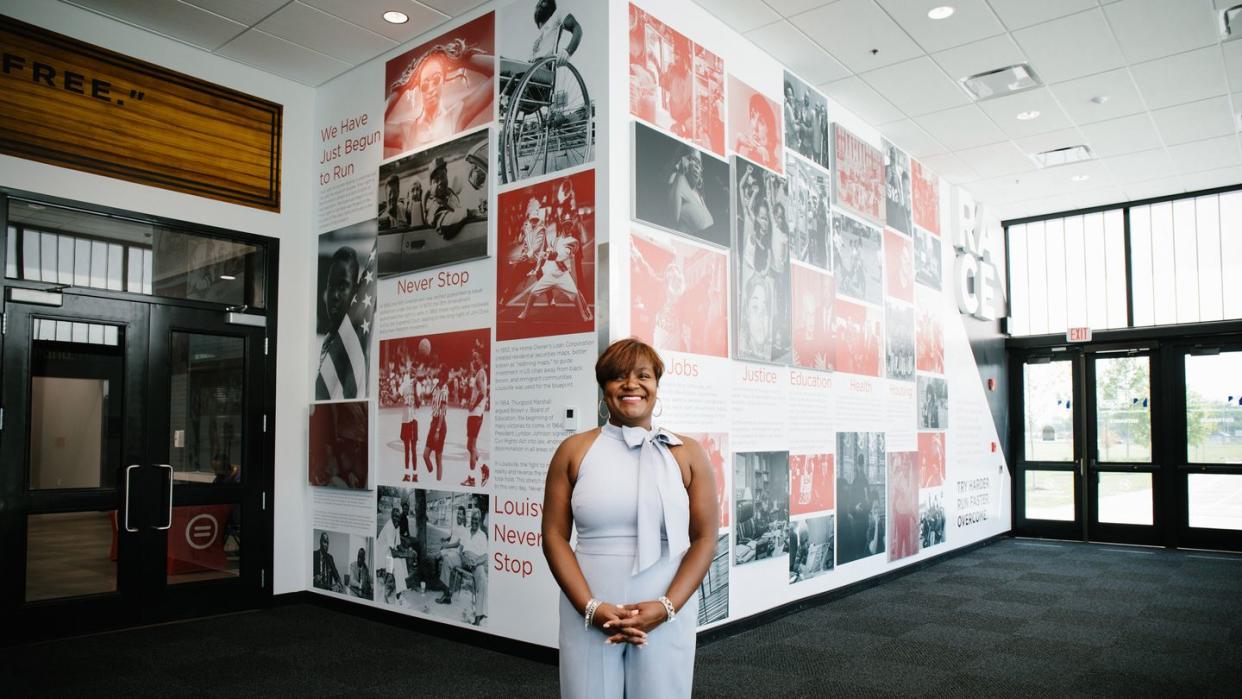
- Oops!Something went wrong.Please try again later.
On the bus ride to her first track meet, Sadiqa Reynolds sits alone. She passes the long drive in silence, gazing at the lush Kentucky greenery. It’s the summer after fifth grade in the early ’80s. No practice under her belt, and therefore understandably intimidated, she’s laced up her sneakers and boarded the bus, and now is listening to her new teammates chatter.
This day is about to swing way up because when Reynolds crouches for the start of her first race ever—the 100-meter—and the gun pops, speed she doesn’t know she has shoots her down the straightaway into first place.
On the bus ride home, she’s a star. Her teammates crowd her like an old pal, and she feels charged up, triumphant, somehow bigger in the very 11-year-old body she woke up in.
She’ll keep winning over the next few years. She’ll even earn the award for “fastest girl” at her sixth-grade graduation. And then, like a lot of kids, she’ll eventually tire of track and leave it behind.
But the sport leaves its imprint. “I learned from track that I was stronger than I thought I could be,” she says. “That I could deliver under pressure.” In that blank sliver of space before the gun went off, she remembers feeling fearful, rattled by raucous cheering sections for big teams.
But time after time, she’d hear those roars, run scared, and win.
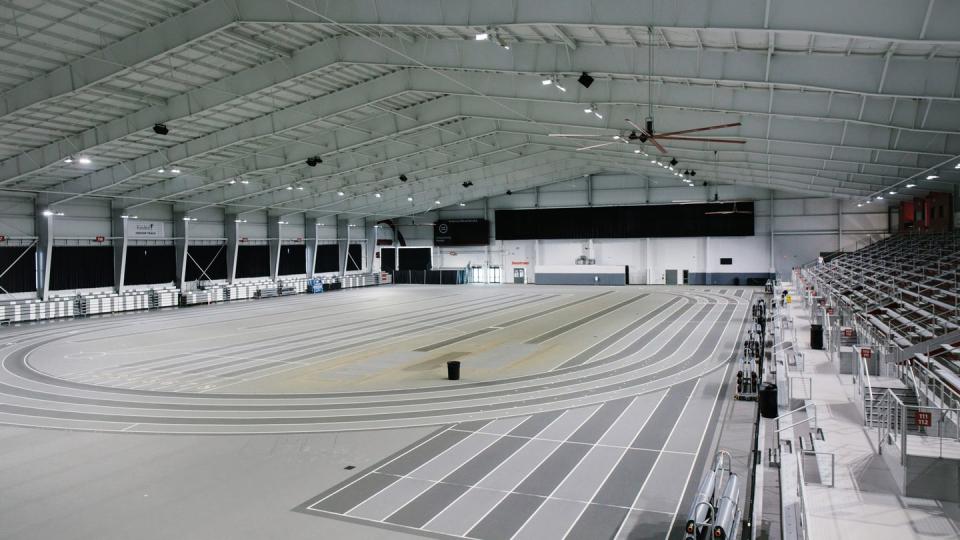
• • •
Decades later, in 2016, Reynolds, a sharp dresser who has sparkling brown eyes, is the CEO and president of the Louisville Urban League, a civil rights organization. She’s particularly focused on Russell, a long-neglected, predominantly Black neighborhood of about 9,000 residents, where the poverty rate is more than three times higher than the rest of Louisville.
A high-profile development slated for a 24-acre brownfield in Russell, where a tobacco factory once sat, is being called off. Lying in bed one night shortly after this is announced, Reynolds prays: What could bring hope, jobs, investment into Russell?
When she opens her eyes, sprinter Usain Bolt is on television, medals draped around his neck. Aha.
Track teams are big; meets would attract runners, coaches, parents, and fans into west Louisville. Reynolds especially likes that track is an “equalizer” sport. “All you need is shoes and determination,” she says.
She envisions a multimillion-dollar indoor track facility that will lure professional, collegiate, and youth competitions, radiating new energy (and money) into Russell. If she could carve that feeling of pride she felt on the bus all those years ago into pieces and deliver them to each doorstep in Russell, she would. Instead, she vows to recreate it.
• • •
Born in New York City’s South Bronx, and raised by a single mother who moved the family to Kentucky when she was young, Reynolds was a kid eager for attention, and could win an argument long before she set foot into law school. She was the first Black woman to clerk for the Kentucky Supreme Court; she describes herself as a “quick study,” and she is the mother of two teenage daughters.
In 2017, after the development for the lot in Russell is suddenly canceled, the city holds a contest for new proposals.
Reynolds, who spent months gathering community feedback, makes her pitch: a 200-meter, six-lane indoor track with the same springy Mondo surface that Olympians will run on in Tokyo 2020. Hydraulic banking will allow corners to lift and lower in three minutes. Its turns will curve at a 21-foot radius, rather than 18-foot, helping sprinters reach record speeds.
Next to the indoor track, there will be an adjoining outdoor track that’s open to the public. There will be space for events and educational programs, and during construction, 40 percent of its hires will be from Black-owned contractors and companies—a far higher target than most construction projects in the state.
She highlights the lack of indoor track facilities in the South and Midwest that are equipped to handle USATF, NCAA, and other serious competitions. And, in Louisville, no collegiate track teams have indoor tracks.
Reynolds estimates that a facility like the one she’s proposing could draw about 30,000 visitors who, at first, would likely spend most of their money in hotels and restaurants downtown, but eventually, surely, she believes, there would be an economic ripple into Russell.
It is called the “Track on Ali,” a nod to Muhammad Ali, who spent much of his childhood in west Louisville, and when it’s all said and done, it will pack in 4,000 spectators. “If we host it, they will come,” she promises.
“At first you’re like, ‘yeah, okay, oh, here we go again,’” says Jackie Floyd, a 70-year-old longtime Russell resident and community organizer who has witnessed plenty of development ideas in west Louisville hyped up then dropped. But the more Reynolds
shares her vision, the more Floyd and her neighbors warm to it. “She was like a preacher,” Floyd recalls. “She kept talking about [the track] with such conviction.”
Reynolds’s proposal wins the contest.
One year later, the city hands $10 million to the Louisville Urban League to get going. At a press conference, Reynolds is surrounded by students dressed in red and gold, the colors of the Westside Track Club, a 40-year-old running program that attracts dozens of kids from west Louisville each year.
Back in the ’80s and ’90s, runners like Reynolds trained on asphalt tracks. “The worst surfaces,” recalls Shonna Johnson, the current Westside head coach who grew up running with the team. Even throughout the new millennium, William Green, known as “Coach Jelly” to his middle- and high-school track athletes, used school hallways to train his runners when temperatures dropped.
“We need to build some success in the hood. We need to show some gold medals in the hood,” Reynolds says at the press conference, her voice growing louder. “This is about watching people fly that look like you.”
In 2018 and 2019, neither a camera nor microphone will escape Reynolds without her making a plea: donations, corporate sponsorships, money, we need the money to build this indoor track. It will ultimately cost $53 million.
Christina Shadle is Reynolds’s right-hand woman at the Louisville Urban League during this period of fundraising and construction. (Technically: investment director.) Set aside COVID-19 and protests and all that was on the horizon—this project, Shadle says, is a Herculean challenge even in the best of times.
“You’re talking about a brownfield in an intentionally uninvested neighborhood with a Black-led civil rights organization that hadn’t done commercial development of the scale before,” she says. Some people were “thinking it could never be done.”
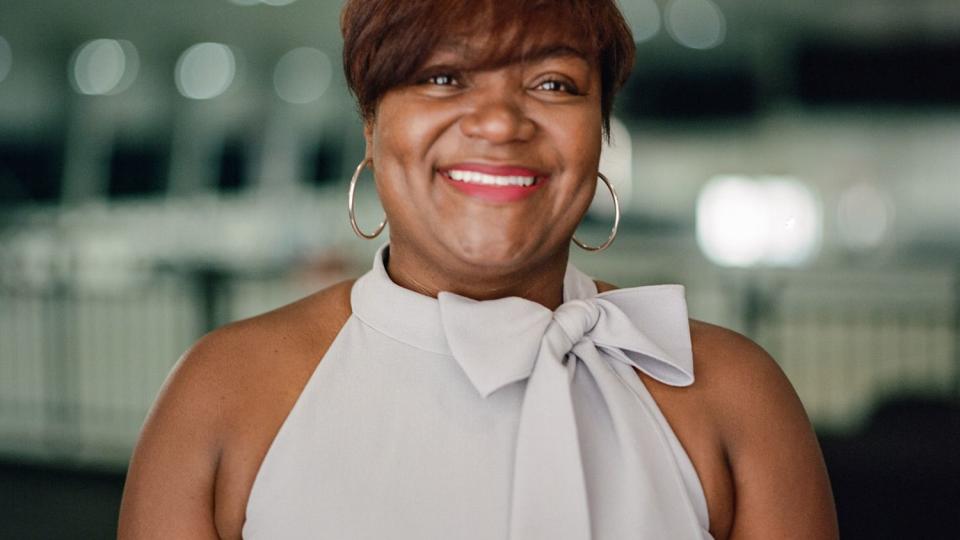
• • •
The 24-acre lot in Russell is roughly the size of 20 football fields. It’s wedged between a railroad track and residential streets lined with shotgun-style homes and elegant Victorians dating back to the late 1800s, when a tobacco magnate and real estate developers founded the neighborhood. By the 1920s, Russell had largely become home to Black residents, with a vibrant stretch of clubs, businesses, and churches.
In the early 1930s, the federal government created the Home Owners’ Loan Corporation (HOLC) to make homeownership more widely available during the Great Depression. It set off a practice of “redlining,” in which Black neighborhoods were often deemed “low quality.” As a result, residents in those communities were denied home loans, and their overall property value sank. A few decades later, in the 1960s, urban renewal arrived, demolishing neighborhoods labeled as slums. Black communities, including Russell, saw Black-owned businesses leveled to make room for highways.
Over time, the east side of Louisville, which is also the whiter side of Louisville, got the higher-performing schools, higher-valued homes, and shopping malls. West Louisville, including Russell, which remains a neighborhood with about 90 percent Black residents, got saddled with boarded-up properties, low-income rentals, and liquor stores.
“All the good stuff goes to the east end, and the west end don’t get anything, right?” says Coach Jelly, a former resident of west Louisville.
Russell’s residents have been advocating for themselves in city hall for decades, frustrated that their once-thriving community was losing businesses but gaining crime and highway pollution. Many of those historic Victorian homes were carved into apartments, or simply abandoned. The neighborhood was losing its people, too. From 1950 to 1980, the population dropped by nearly 63 percent, and it has trended down since.
For more than a century, a tobacco factory sat on the 24-acre lot that employed many Russell residents in the later half of the 20th century. In 2010, when the factory closed, and most of the buildings were demolished, arsenic, heavy metals, and other contaminants were left to linger in the dirt. Concrete cracked. Weeds sprouted. The lot sat empty for more than a decade, reminding the people of Russell: This is what we get.
The west end of town is home to several other brownfields. And for decades, residents here have been exposed to toxic emissions from a rubber manufacturer and a chemical factory. A 2017 health equity study found that proximity to these industrial sites contributes to a life expectancy in west Louisville that is 10 to 12 years lower than other parts of the city.
Not much ever changed in Russell. Promises came, then faded. “Growing up down here,” says Aaron Williams, who lived near those 24 acres as a teenager, “you notice what you don’t have when you go other places.”
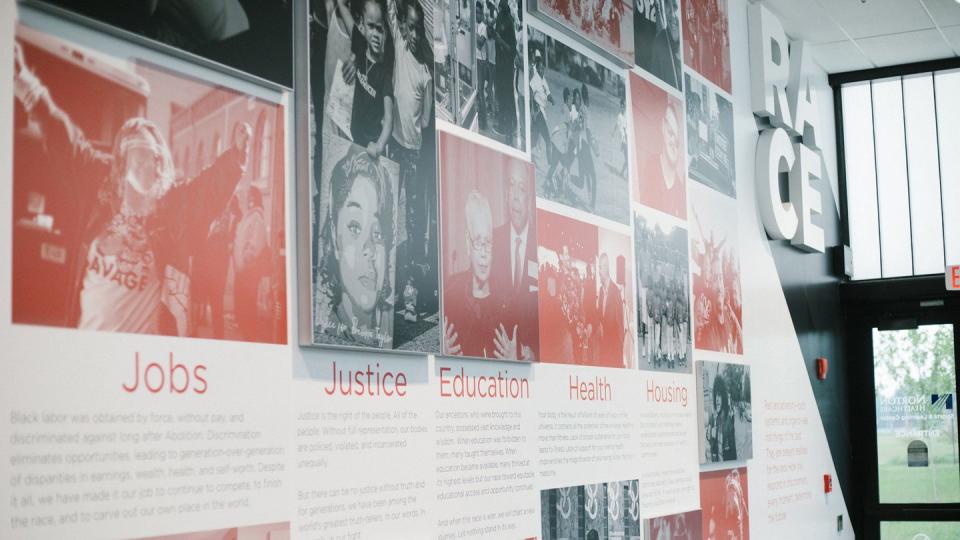
• • •
A week before Thanksgiving in 2019, Reynolds is on the local CBS affiliate, in a gold sweater, interrupting The Price Is Right and The Bold and the Beautiful, taking pledges from locals who want this track built. Dubbed the #RunWithUs telethon, it started at 6 in the morning and will stretch until 10 at night, breaking into programming and taking over newscasts. Local telethons typically follow a disaster. That airtime was dedicated for this one project is “rare,” says Shadle.
Reynolds is sandwiched between volunteers, picking up calls, when she talks with one woman who says she’s in the hospital, watching, and wants to commit $5 a month. “She said she wanted to see change in her lifetime,” Reynolds says. A grandmother donates $50 in memory of her grandson who was killed. A soft-spoken 15-year-old, Jaylen Jackson, shares that a fundraiser he created for his birthday raised $2,400 for the track. “God gave us a second chance to use this space, and we should take advantage of that,” he says to the telethon host. In total, the effort brings in $161,000.
Away from phone lines, Reynolds can whip up a crowd. At the track’s groundbreaking ceremony, she speaks with evangelical zeal: “This is about bringing hope to a community! This community deserves this!” And before you know it, she’s orchestrating a reverse Oprah-you-get-a-car moment because people are giving her gifts, pledging $5,000, another $5,000, $20,000, on and on until nearly $300,000 is raised in 15 minutes.
Throughout the fundraising process, Shadle later tells me, Reynolds never lets anyone have the upper hand. She walks into every meeting as an equal and never minces words. In one instance, she states to a potential funder: “I have a $22 million gap to fill. How close can you get to filling it?” One possible donor who suggests yet another meeting before committing, is told, as Shadle recalls: “‘You know, you either need to piss or get off the pot.”
One woman wins $500 in the lottery and drives to the Louisville Urban League to hand over $100. A group of prominent business leaders unite to give $3 million. Reynolds and Shadle secure $7 million in complex federal tax credits.
Norton Healthcare, a large, not-for-profit healthcare company based in Kentucky, commits $5 million to the project. In return, the Track on Ali becomes the Norton Sports and Learning Center. For some who still doubt this track will ever open, that name, though hardly hot, signals that this is for real. A big-name healthcare company wouldn’t lend its brand to a sinking ship.
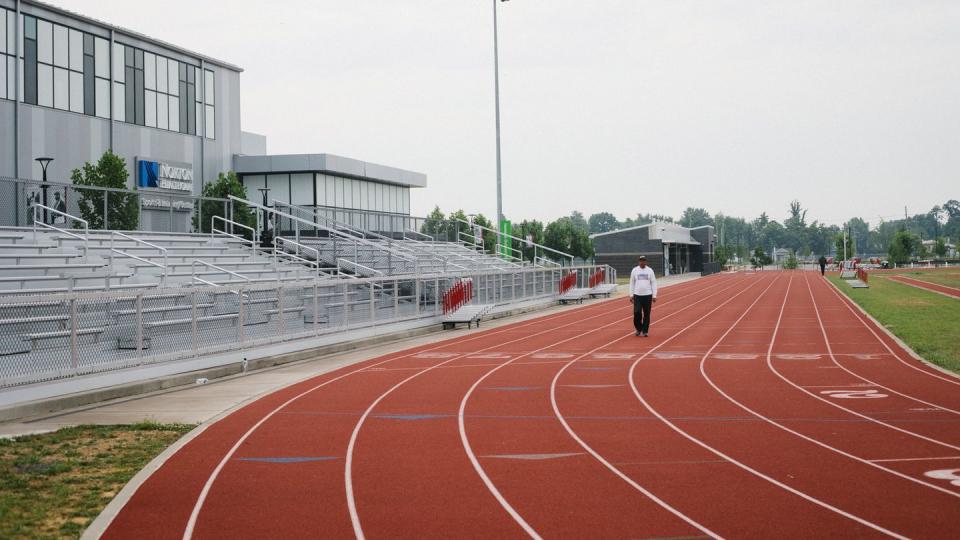
• • •
Reynolds sits at a table in a back corner office at the Louisville Urban League, listening to the purr of midday traffic. Two other executives are with her, but the rest of the two-story building is empty.
It’s March 13, 2020. The gravity of Covid is sinking in, and Reynolds has sent 60-plus people on her staff home with a return date of TBD. Earlier in the day, Kentucky’s governor closed senior centers and other buildings to the public. Reynolds and her team are wrestling with how to continue their job training and educational programming.
Shutdowns are just beginning and scattershot, and Reynolds is anxious that the governor may pull the plug on construction work, landing her track project, which has already broken ground, in purgatory.
In just the last few months, the 24-acre project site has evolved from weeds to steel beams to a towering rib cage that’s signaling to the community: This is real. It’s coming.
At one point, Reynolds looks out the window and notices the crisp sunshine. It will later register as an odd touch for a grim day, one that demarcates the before and after times.
It started with a morning phone call from the deputy chief of the Louisville Metro Police Department. She alerted Reynolds that a few hours earlier, undercover officers broke down the door of a Black woman’s apartment, and shot and killed her while executing a “no-knock” warrant related to a drug investigation centering on not the woman herself but a man the woman knew. As the leader of the most visible civil rights organization in the city, and a former public defender and judge, the debacle strikes Reynolds as deeply problematic, suspicious.
“And then all hell broke loose,” she recalls.
In the late spring and summer of 2020, as the story of Breonna Taylor finally surfaces, nightly protests erupt. Police helicopters loop like nocturnal birds. Reynolds is in the streets. Stepping over shattered glass. Shouting into bullhorns and from microphones: “Say her name!”
“Ending racism in Louisville, in America,” she says to the press one morning after violent protests, “is not the responsibility of Black people. That work belongs to white people. White people who created it, sustain it, and benefit from the systems of oppression.”
Reynolds and others on her team hear grumbles that perhaps she’s being a little too vocal during the uprisings, that it may sour potential donors or future corporate sponsors of the track. (The governor never shut down construction sites.) She does not pause. Over the summer and fall of 2020, there are “no minutes to sleep,” Reynolds recalls.
In August 2020, Reynolds learns that a $10 million donation from an out-of-state philanthropic investor has been pulled, and she panics. She’s squeezed every dollar out of the Louisville community. Trying to ask for more from potential funders at a time when Covid is killing hundreds of thousands of people feels wrong.
When an Act of God strikes, contracts can be broken, and 2020 certainly feels like the end of days. She could absolutely put the track project on hold. A few people advise her to do so. But that will force her to lay off 302 workers.
On top of trying to build a world-class track facility, and the civil unrest, the Louisville Urban League is helping seniors, kids, and the suddenly unemployed through Covid. When Reynolds tries to lie down and get some rest, it’s no use.
So she often drives to the 24-acre lot and stands in the dirt. In the moonlight, the hard angles of construction soften—the whole world does, really—and she listens. It is quiet except for her own breath. In the stillness, she recalibrates. She imagines the track like a magnetic force, pulling in crowds from all corners of the state, the country, maybe one day even the world. This project, which depends on the goodwill of white people and Black people, rich and poor, is a “contradiction from everything happening in the world.” I must finish this, she thinks.
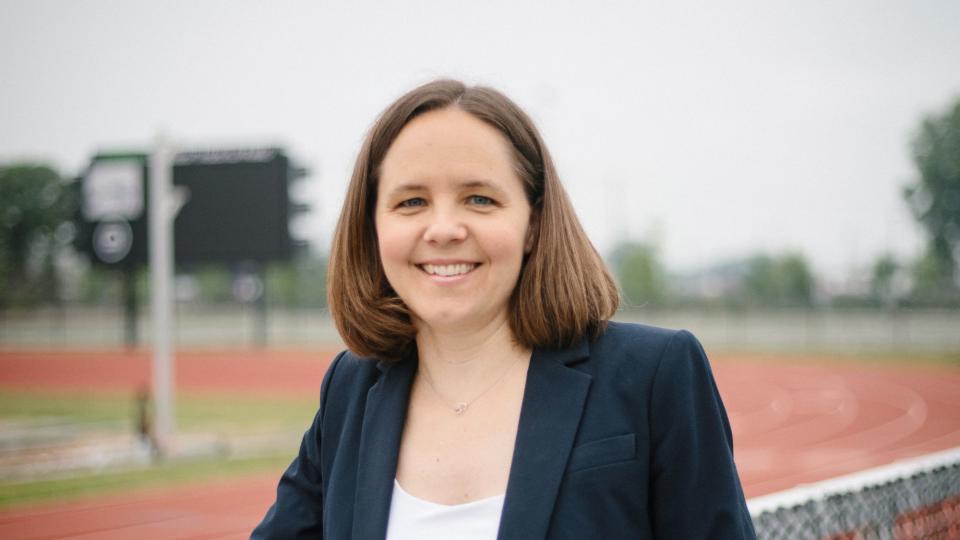
• • •
On February 17, 2021, a sunny day with snow sticking to the ground, the Norton Sports and Learning Center opens its doors, and the indoor running track hosts its first meet. The cartoonist for The Courier Journal, the local newspaper, illustrates a picture of Reynolds, sprinting in a red dress and heels, passing a relay baton to a young Black runner in a singlet that reads: West End.
But on that day, after years of wrangling support from the business community, after she’s won over skeptics in the community, after countless media tours of the facility, Reynolds sits paralyzed in the Urban League offices. Too scared to make the seven-minute drive to the track. She misses the crack of the gun starting the first race.
Over the four years it’s taken to build the track, she jokes that “I’d walk through hell in gasoline underwear to get this done.” But there were private moments when doubt swooped in. Could she pull it off? The track started like a work of art, something easy to visualize. But she says the pressure was immense to deliver a promise to people who are “so used to being disappointed.” She’s convinced her phone will soon ring: The hydraulics aren’t working. You forgot about the occupancy permit! The whole meet is a disaster.
All is quiet.
She gets into her car after a few hours and heads to the facility where the University of Louisville, which has never had an indoor track, is hosting a meet. She’s driven this route a million times, taken a million selfies during every phase of construction, like a parent documenting their firstborn.
This should be a moment of triumph, but she’s all nerves knowing the public is now stepping into her vision: Black-owned small businesses line a hallway selling track-themed shirts and gifts. An exterior wall is dedicated to prominent Black figures: John Lewis, Colin Kaepernick, Venus and Serena Williams, and many others.
Right by the front doors, under the word “RACE,” she decided a collage of pictures would forever stand, paying tribute to Breonna Taylor, local activists who demanded justice, and those who were killed in the midst of the unrest. “I wanted people in this community to walk in and understand that they own this,” she says. “And we [built] this in the middle of your pain, and we were right there with you.”
As she gets closer to the building, her eyes lock in on a pack of men. She reaches her phone, fumbling with it and the steering wheel. “I’m driving down the street and here comes five white guys with no shirts on,” she says, with a laugh. “They were [University of] Notre Dame runners. I almost ran them over. I tried to take videos of them running.”
White people running in Russell—this is new. Progress in a Black neighborhood does not require the arrival of white people, but in seeing a herd of distance runners trotting around a space once reserved for tobacco production, Reynolds realizes: My God, it’s working. People are spending their weekends in west Louisville.
• • •
Two years in, that’s how it’s been.
Come spring, Coach Jelly’s middle-school runners gather at the outdoor track every Monday to lace up spikes and compete against middle-school teams from all over the city, their parents sardined in the bleachers.
Across the street from the track, Aaron Williams delights at the sight of a packed parking lot. He recently opened Chicago Jerk Tacos, a Caribbean-style taco restaurant that he started as a food truck, setting up outside the track on competition days. Runners, parents, bus drivers—they’d clean him out. Williams spent his teenage years in west Louisville, a place where, he says, “I didn’t see a lot of people that looked like me running and operating businesses.”
Indoor seasons are booked solid with collegiate competitions, local youth meets, and even USA Track & Field championships, including the National Youth Indoor Championship and the Masters Indoor Championship.
This past spring, Tyreek Hill, a Miami Dolphins wide receiver and former top collegiate sprinter, decided to return to track after a nine-year hiatus, to race in the Masters Championship. He took on the men’s 60-meter dash, in the 25–29 age group. It was easy to spot the professional athlete at the starting blocks. Hill’s every muscle bulged, rendering his competition to look as fierce as paper dolls. His final practice jump before the race was so explosive his feet were nearly level with the shoulders of the athlete one lane over.
As the runners folded into ready position, phones in the crowd were hoisted up to capture the race. The gun popped. Eight steps in, Hill’s winning. Three seconds in... is there a mercy rule in track? By the time he hit the crash pads, the crowd was in awe of a 60-meter race that really wasn’t one. And though Hill’s time (6.70 seconds) wouldn’t secure a victory in major collegiate competitions, Dale Cowper, then head coach of University of Louisville’s track-and-field and cross-country programs, believes such spectacle and celebrity, along with what he dubs a “world-class facility,” will help draw more local kids into the sport.
Even his own student-athletes, Cowper says, felt inspired upon walking into the Norton track for the first time. It enabled him to attract more sprinters and middle-distance runners to his program. “Before this track, we weren’t really focused on having 200-meter runners, 400-meter runners, 800-meter runners because we didn’t have the capabilities to really allow them to be successful during the winter months,” he says. “This track created that opportunity.”
Stephen Gray, head coach of Spalding University, a Division III school in Louisville, echoes that sentiment. As a small program, he used to book high school tracks for practice. Now he can show off the Norton Sports and Learning Center’s indoor and outdoor tracks to recruits. “My roster size is growing like crazy this year,” he says.
And upon sponsoring the track, the CEO of Norton Healthcare decided that the company needed to better serve west Louisville. Last year, he announced that his company would build the first hospital west of Ninth Street in 150 years.
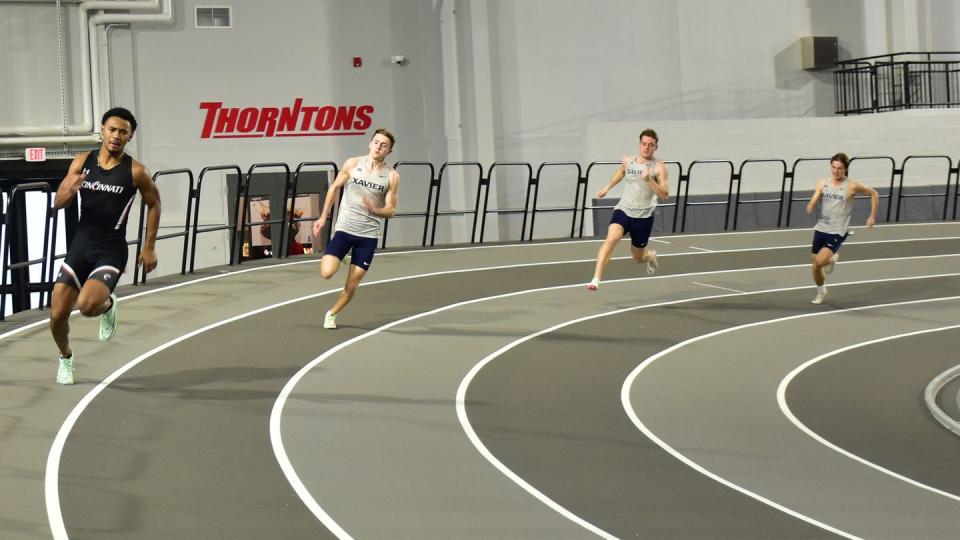
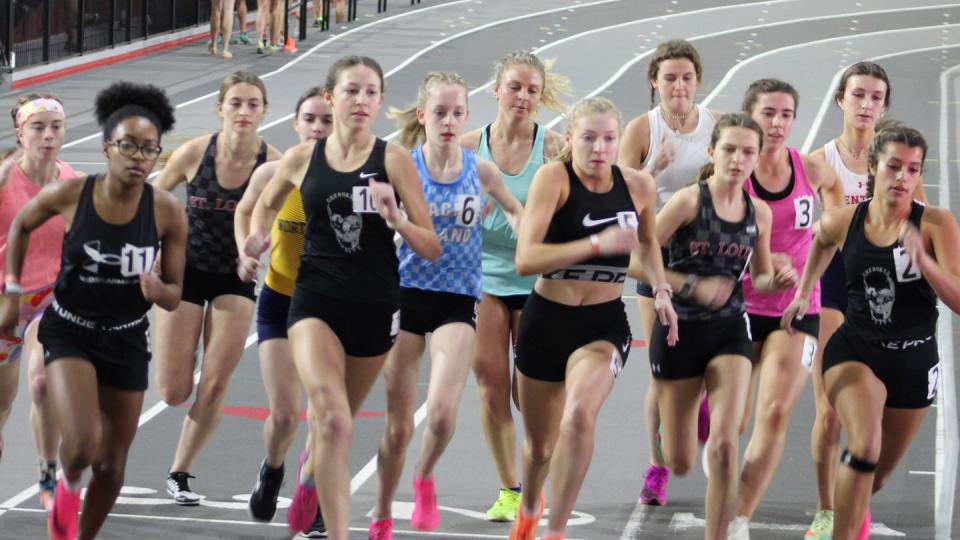
• • •
Not everyone comes to the facility with competition in mind, though.
Every weekday morning, Leon Woolridge steps onto the outdoor track just before 7:30 in the morning and begins his three-mile walk, sometimes alone, and other times with a friend at his side. The 69-year-old watches as the downtown skyline, three miles away, crawls out from darkness and into a pink and orange glow of morning.
Before the facility had opened, he’d walk in neighborhood parks. But the high-quality surface on the outdoor track is gentler on his knees, and he likes that the track has 24-hour security, and lights that flicker on at dusk and blink off around mile two of his walk. Woolridge, a west Louisville native, never once doubted Reynolds. “She had all her ducks in a row,” he says.
Reynolds recently left the Louisville Urban League for a new job, having poured everything into the last five years. She’s still the president of the Norton Sports and Learning Center, fussing about things taped to walls or trash left out, and chasing new sponsorships, new revenue streams.
She’s still in awe every time she sees the facility bustling with athletes, but it’s people like Leon Woolridge, or the women who feel safe jogging at night under the outdoor track’s bright lights, who most frequently stop her to thank her. “It’s like living through your own funeral,” she says. (Underscoring that point, in May, the Louisville city council voted to rename a portion of a street adjacent to the track: Sadiqa Reynolds aka “Run with Us” Way.)
For most of Woolridge’s life, his side of Louisville was home, but certainly not a destination. There simply was never much “down in the west end,” he says. Now the very place where he arrives first thing, gets his steps in, and greets the day is a landmark.
• • •
On a Sunday in mid-March, during the last event of the last day of competition at the National Youth Indoor Championship, a starting gun cracks, and 11- and 12-year-olds bolt. Sprinters in the neon green uniforms of Long Beach, California’s Compton Electric Speed track club command the lead through the first three legs of the 4x400 relay.
With two laps left, the aluminum stands vibrate with Richter-scale intensity. Rival parents who’ve traveled from Prospect Park in Brooklyn stomp and bounce. Their final runner, baton in hand, is off—his long, light strides glide across the track, and the gap is closing, closing, closing.
On the final stretch, Prospect Park surges past Compton Electric. The comeback ignites the place; ecstatic screeches build to crescendo, and one parent with an injured foot raises her crutches overhead and hops on her good leg. This is the energy that Reynolds envisioned all those years ago.
Sometimes, on competition days, she records the noise so that later she can go home, close her eyes, and listen.
You Might Also Like

